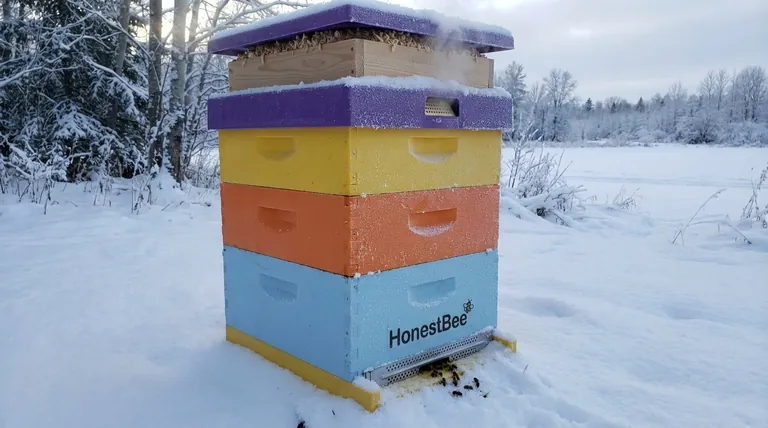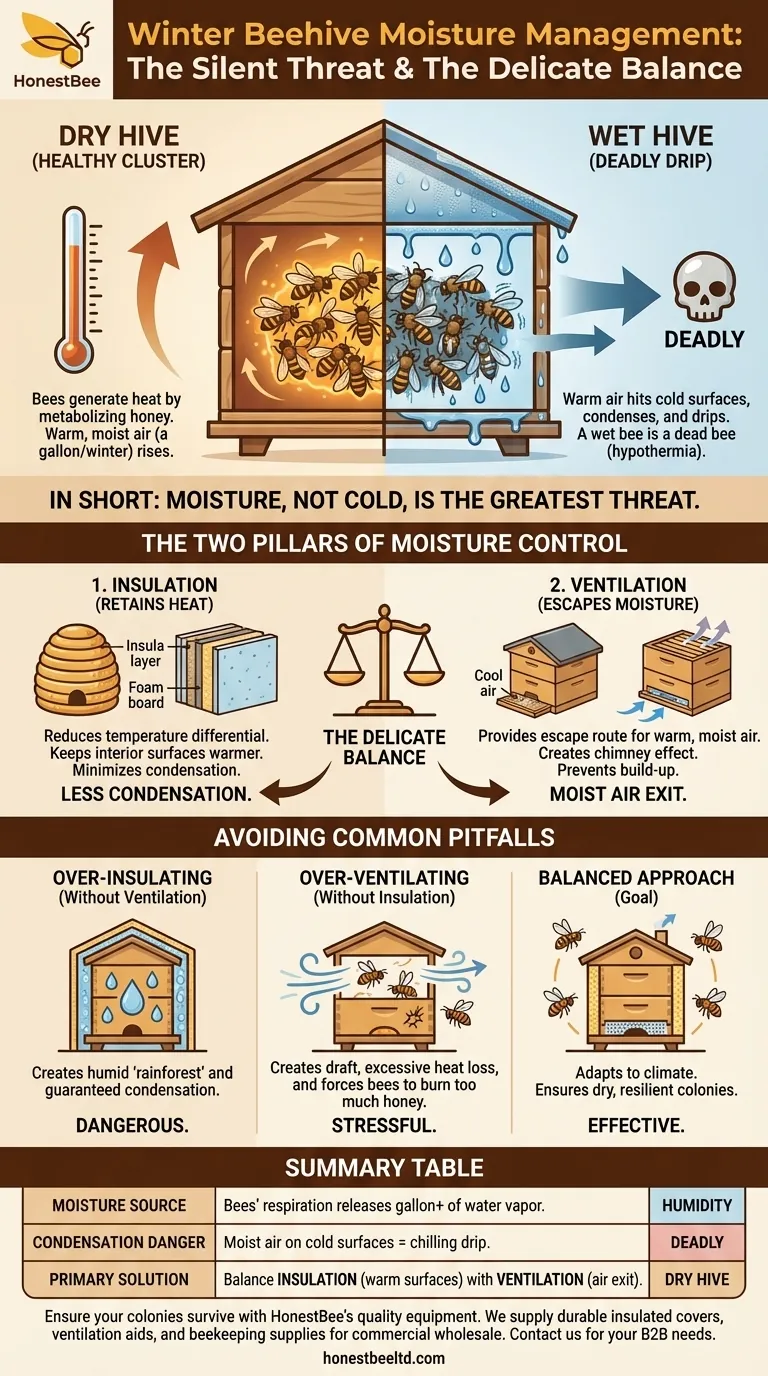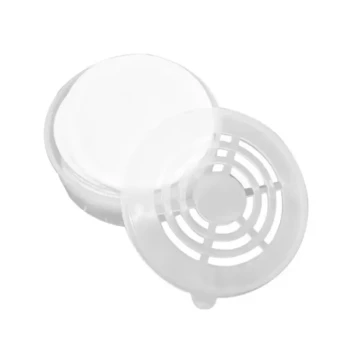In short, moisture is the single greatest threat to a honey bee colony during winter. While many assume cold is the primary danger, a healthy, dry cluster of bees can generate sufficient heat to survive frigged temperatures. It is the presence of excess moisture, which leads to condensation and a cold, deadly drip, that most often proves fatal.
The central challenge of winter beekeeping is not eliminating moisture—an impossible task—but managing it. Success hinges on striking a delicate balance between insulating the hive to retain heat and ventilating it to allow moist air to escape.

The Physics of Winter Hive Moisture
To properly manage moisture, you must first understand where it comes from and why it becomes so dangerous inside a confined space like a beehive.
Where Does the Moisture Come From?
Bees generate heat by forming a tight cluster and metabolizing their honey stores. Just like us, a major byproduct of their respiration is warm, water-saturated air. A single colony can release over a gallon of water vapor into the hive atmosphere over the course of a winter.
Condensation: The Silent Killer
This warm, moist air rises from the bee cluster. When it makes contact with a cold surface—typically the underside of the hive's inner cover or lid—it rapidly cools and condenses into liquid water. This is the exact same principle as a cold glass of water "sweating" on a humid day.
Why Wet Is Worse Than Cold
This condensed water then drips back down onto the bees. A wet bee is a dead bee. The chilling effect of cold water robs them of body heat far faster than cold air alone, leading to hypothermia and death. Furthermore, a perpetually damp environment is the perfect breeding ground for mold and other pathogens that can sicken the colony.
The Two Pillars of Moisture Control
The references are clear: the solution to deadly condensation lies in the strategic interplay of two key principles: insulation and ventilation.
The Role of Insulation
Insulation is crucial for reducing the temperature differential that causes condensation. By wrapping the hive or adding foam board insulation, you keep the interior surfaces of the hive warmer. When the rising moist air hits a warmer surface, less condensation will form.
A well-insulated hive also helps the bees conserve energy. They need to burn less honey to maintain their cluster temperature, reducing the risk of starvation.
The Role of Ventilation
Ventilation provides an escape route for the warm, moist air. By creating a small opening at the top of the hive, this water vapor can exit before it has a chance to condense on the ceiling. This creates a natural chimney effect, pulling dry, fresh air in from the bottom entrance and pushing damp air out the top.
Finding the Right Balance
Insulation and ventilation are not opposing forces; they are a team. Insulating a hive without providing any ventilation is a recipe for disaster, as it will trap all the moisture inside. Conversely, over-ventilating without adequate insulation can create a cold, drafty hive, forcing the bees to burn through njihov honey stores.
Understanding the Trade-offs
Achieving the right balance requires avoiding common pitfalls. Your specific climate will determine which of these you need to be most aware of.
The Pitfall: Over-Insulating Without Ventilation
This is the most common mistake. A beekeeper, wanting to keep their bees warm, seals the hive up tight and wraps it heavily. This creates a humid "rainforest" inside, where condensation is guaranteed. This is far more dangerous than the cold itself.
The Pitfall: Too Much Ventilation
Creating a large opening for ventilation, especially in a frigid climate, can create a wind tunnel. The draft can stress the bees and forces them to consume excessive amounts of honey just to stay warm, increasing the risk of starvation. An entrance reducer is essential to control the lower opening, but it must not be the only factor in your ventilation plan.
The Pitfall: Ignoring Hive Health
A strong, populous colony with ample honey stores is better equipped to manage its environment. A small, weak colony will struggle to generate enough heat, making proper insulation and moisture management even more critical for its survival.
Making the Right Choice for Your Goal
Your strategy should be adapted to your climate and the specific needs of your bees.
- If your primary focus is survival in a severely cold climate: Prioritize heavy insulation on the top and sides of the hive, combined with a small, dedicated upper entrance or vent (about one-square-inch) to allow moisture to escape.
- If your primary focus is management in a mild but damp climate: Emphasize top ventilation. Use a "quilt box" with wood shavings or a cracked outer cover to ensure damp air has a clear exit, paired with more moderate insulation.
- If your primary focus is a simple, effective setup: Use a quality insulated inner cover and ensure a small upper ventilation gap. This single piece of equipment both insulates and helps manage condensation at the most critical point.
Ultimately, remember that you are managing the hive's internal atmosphere to keep your bees dry, not just warm.
Summary Table:
| Key Aspect | Why It Matters |
|---|---|
| Moisture Source | Bees release a gallon+ of water vapor via respiration, creating a humid environment. |
| Condensation Danger | Moist air hits cold surfaces, condenses, and drips, chilling and killing bees. |
| Primary Solution | Balance Insulation (keeps surfaces warm) with Top Ventilation (lets moist air escape). |
| Common Mistake | Over-insulating without ventilation traps moisture, creating a deadly 'rainforest' inside. |
Ensure your colonies survive the winter with the right equipment. Proper moisture management starts with quality hive components. HONESTBEE supplies durable, well-designed beekeeping supplies and equipment—like insulated inner covers and ventilation aids—to commercial apiaries and beekeeping equipment distributors through our wholesale-focused operations. Let us help you build a stronger, more resilient operation. Contact our expert team today to discuss your wholesale needs.
Visual Guide

Related Products
- Professional Insulated Plastic Bee Hives
- Professional Insulated Winter Hive Wrap for Beekeeping
- Langstroth Bee Hives Bee Keeping Box for Beginners Beekeeping
- Wholesales Dadant Size Wooden Bee Hives for Beekeeping
- Honey Flow Garden Bee Hive Flow Hive Best Beehive for Beginners
People Also Ask
- What is the purpose of a bee box? A Complete Guide to Modern Hive Management
- Why is it recommended to buy at least two bee hives? Boost Your Success with a Second Colony
- Is polystyrene bee hive better than wood? Superior Insulation for Healthier Bees & More Honey
- How does the orientation of the hive sides benefit comb construction? Ensure Straight, Movable Combs for Easier Hive Management
- What are the environmental benefits of EPS bee hives? Boost Colony Health and Reduce Your Eco-Footprint



















